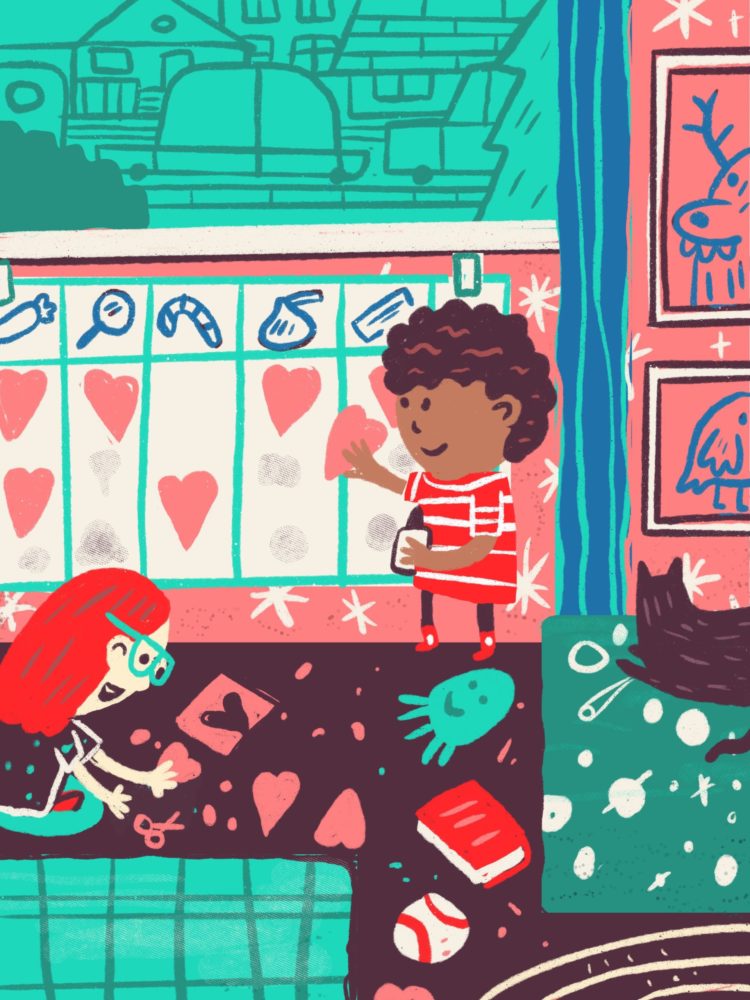The tough part about being a write-from-home parent is the children. Playing “pretend coffee shop” will only net thirty minutes of often-interrupted time, so writing is often squeezed into the margins of the day when they’re in bed or occupied. The rest of the time, you’re writing with kids.

“Kids are great collaborators…” Illustration by Josh Quick
Although drafting and editing are near-impossible while kids are at home and awake, researching is often improved by having kids around. Of course, you can’t just sit a five-year-old in front of your computer and ask him to set up Google News alerts.
You can, however, enlist a junior research assistant in other projects. In Part III of the Creative Research Series, you’ll find three ways to invite kids into your research, leading to richer and more fun writing.
Ask irresistible questions
The best research questions are the ones that you, the writer, desperately want to answer. The easiest way to get buy-in from a junior research assistant is to ask questions that kids desperately want to answer. Many such questions involve snack food. What’s the best flavor of Cheez-It? Does year-old Halloween candy still taste good? What’s the best lunchbox snack sold at Costco?
Kids are great collaborators on many food-based queries, and can often supply the anecdotal evidence that adds color and shape to your writing. After realizing that the cook times on whimsical, kid-directed pasta shapes were considerably longer than adult-directed pasta, I offered my own junior research assistant a taste test: try the same shape of pasta, cooked in 1-minute increments. The anecdotes from that taste test could not prove that kids like al dente pasta as much as adults, but they did help pose a larger question about why we think kids need “kid” foods.
Create surprising categories
Strong researchers tend to sit with their data for a while, continuously sifting until patterns emerge. This process, however, is often counterintuitive to adults with looming deadlines. Inviting kids into your research process can help create the space to just sit and think before trying to draw conclusions.
An assignment to write about conversation hearts might start with you categorizing the candies by brand, or perhaps by theme (romance, friendship, etc.). But kids, who are endless categorizers, can see patterns that grown-ups might miss. My own junior research assistant, for example, separated the hearts into those with sight words and those without, leading me to a fresh new take on what seemed like a done-to-death topic. Taking the time to sit and create categories with him opened up new questions for my research.
Seek kids’ expertise
Instead of developing a topic and encouraging your kids to help you with the research, consider studying something your kids love and deferring to their expertise. When writing with kids, ask what yours is an expert in and then ask him to share that knowledge with you.
My junior research assistant, like so many children his age, is obsessed with unboxing videos on YouTube, and that obsession makes him well-suited to playing “Guess that Tune” with uncredited music. After I heard a familiar bouncy tune on a podcast, I asked him to help me track down the song. We clicked through songs in YouTube’s audio library together and his favorites led to a fun, wandering research project into how YouTube music gets made and the wide range of uses it gets put to.
Kids are great co-researchers because they can help us make new connections and draw surprising conclusions. Other forms of research can remind us that what seems new is actually much older than we think. Stay tuned for Part IV, where we’ll look at how to use archival materials to find old answers to old questions.
Was “Writing with Kids” your introduction to this series? Catch up with Part I, “Researchstorming: How to Research Before You Write,” and Part II, “Pick the Whole Orchard: How to Batch Your Freelance Research.”

